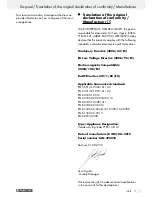
10 GB/IE
General safety advice for electrical power tools
General safety advice for electrical power tools
correctly sized accessories cannot be adequately
controlled.
e)
The arbour size of wheels, sanding
drums or any other accessory must
properly fit the spindle or collet of the
power tool.
Accessories that do not match
the mounting hardware of the power tool will
run out of balance, vibrate excessively and may
cause loss of control.
f)
Mandrel mounted wheels, sanding
drums, cutters or other accessories
must be fully inserted into the collet
or chuck.
If the mandrel is insufficiently held
and / or the overhang of the wheel is too long,
the mounted wheel may become loose and be
ejected at high velocity.
g)
Do not use a damaged accessory. Be-
fore each use inspect the accessory such
as abrasive wheels for chips and cracks,
sanding drum for cracks, tear or excess
wear, wire brush for loose or cracked
wires. If power tool or accessory is
dropped, inspect for damage or install
an undamaged accessory. After inspect-
ing and installing an accessory, position
yourself and bystanders away from
the plane of the rotating accessory and
run the power tool at maximum no-load
speed for one minute.
Damaged accesso-
ries will normally break apart during this test time.
h)
Wear personal protective equipment.
Depending on application, use face
shield, safety goggles or safety glass-
es. As appropriate, wear dust mask,
hearing protectors, gloves and work-
shop apron capable of stopping small
abrasive or workpiece fragments.
The
eye protection must be capable of stopping
flying debris generated by various operations.
The dust mask or respirator must be capable of
filtrating particles generated by your operation.
Prolonged exposure to high intensity noise may
cause hearing loss.
i)
Keep bystanders a safe distance away
from work area. Anyone entering the
work area must wear personal protec-
tive equipment.
Fragments of workpiece or
of a broken accessory may fly away and cause
injury beyond immediate area of operation.
j)
Hold power tool by insulated gripping
surfaces only, when performing an op-
eration where the cutting accessory
may contact hidden wiring or its own
cord.
Cutting accessory contacting a «live» wire
may make exposed metal parts of the power
tool «live» and could give the operator an elec-
tric shock.
k)
Always hold the tool firmly in your
hand(s) during the start-up.
The reaction
torque of the motor, as it accelerates to full speed,
can cause the tool to twist.
l)
Use clamps to support workpiece when-
ever practical. Never hold a small work-
piece in one hand and the tool in the
other hand while in use.
Clamping a small
workpiece allows you to use your hand(s) to
control the tool. Round material such as dowel
rods, pipes or tubing have a tendency to roll
while being cut, and may cause the bit to bind
or jump toward you.
m)
Position the cord clear of the spinning
accessory.
If you lose control, the cord may
be cut or snagged and your hand or arm may
be pulled into the spinning accessory.
n)
Never lay the power tool down until
the accessory has come to a complete
stop.
The spinning accessory may grab the
surface and pull the power tool out of your
control.
o)
After changing the bits or making any
adjustments, make sure the collet nut,
chuck or any other adjustment devices
are securely tightened.
Loose adjustment
devices can unexpectedly shift, causing loss of
control, loose rotating components will be vio-
lently thrown.
p)
Do not run the power tool while car-
rying it at your side.
Accidental contact
with the spinning accessory could snag your
clothing, pulling the accessory into your body.
q)
Regularly clean the power tool’s air
vents.
The motor’s fan will draw the dust inside
the housing and excessive accumulation of pow-
dered metal may cause electrical hazards.











































